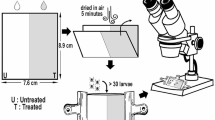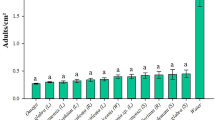Abstract
Increasing resistance against synthetic insecticides, mosquito control is becoming serious problem. For an alternative measure novel botanical sources can be used as good insecticides with less toxic hazards to the environment. The present study estimated larvicidal activities of Andrographis echioides against the vector of lymphatic filariasis Culex quinquefasciatus under laboratory conditions. Crude extracts of A. echioides mature leaves were examined for mosquito larvicidal activity against all the larval instars of Cx. quinquefasciatus. Solvent extraction was carried out using three different solvents viz. petroleum ether, ethyl acetate and acetone. Dose dependent larvicidal bioassays were performed using the solvent extractives. LC50 and LC90 values were consummated through log-probit analysis. Regression and ANOVA analyses were done for statistical justification. The effects of crude and solvent extractives were tested on a non-target water fauna. Crude extract of A. echioides leaf exhibited 100% mortality in 1.00% concentration against 1st instars larvae after 72 h of exposure. Among three used solvent extracts ethyl acetate showed efficient larvicidal effect against target mosquito. In ethyl acetate extractive 100.00% mortality was noticed at 150 ppm concentration against 1st instars larvae after 48 h of exposure with LC50 and LC90 values of 32.96 ppm and 106.96 ppm respectively. Tested non target organism was completely safe both from crude and ethyl acetate extractives. This experiment was a pioneer attempt to establish A. echioides as a precious resource for production of mosquito larvicide against Cx. quinquefasciatus.
Similar content being viewed by others
References
Abbott, W.S. 1925. A method of computing the effectiveness of an insecticide. Journal of Economic Entomology 18: 265–266.
Barraud, P.J. 1934. The Fauna of British India, including Ceylon and Burma. Diptera Vol -IV, 1–455. London: Taylor and Francis.
Bhattacharya, K., and G. Chandra. 2013. Bioactivity of Acyranthes aspera (Amaranthaceae) Foliage against the Japanese Encephalitis Vector Culex vishnui Group. Journal of Mosquito Research 3(13): 89–96.
Bhattacharya, K., and G. Chandra. 2014. Phagodeterrence, larvicidal and oviposition deterrence activity of Tragia involucrata L. (Euphorbiaceae) root extractives against vector of lymphatic filariasis Culex quinquefasciatus (Diptera: Culicidae). Asian Pacific Journal of Tropical Disease 4(Suppl 1): S226–S232.
Bhattacharya, K., and G. Chandra. 2015. Biocontrol efficacy of Operculina turpethum (L.) (Convolvulaceae) leaf extractives against larval form of malarial mosquito Anopheles stephensi (Liston 1901). International Journal of Pharma and Bio Sciences 6(3): 460–468.
Bhattacharya, K., S. Burman, S. Nandi, P. Roy, D. Chatterjee, and G. Chandra. 2014a. Phytochemical extractions from the leaves of Ravenala madagascariensis from Sundarban area and its effect on southern house mosquito (Culex quinquefasciatus Say 1823) larvae. Journal of Mosquito Research 4(12): 1–6.
Bhattacharya, K., I. Chandra, P. Kundu, S. Ray, D. Halder, and G. Chandra. 2014b. Larval control of Culex vishnui group through bio-active fraction of traveller’s tree, Ravenala madagascariensis Sonn. (Strelitziaceae). Journal of Mosquito Research 4(15): 1–6.
Bockarie, J.M., M.P. Erling, B.W. Graham, and E. Michael. 2015. Role of vector control in the global program to eliminate lymphatic filariasis. Annual Review of Entomology 54: 469–487.
Chandra, G. 1995. Peak period of filarial transmission. The American Journal of Tropical Medicine and Hygiene 53(4): 378–379.
Chandra, G. 2000. Mosquito, 1–102. Kolkata: Sribhumi Publication Co.
Chandra, G., and A.K. Hati. 1993. Correlation between the preferred biting site of Culex quinquefasciatus and the region of the body affected by clinical filariasis. Annals of Tropical Medicine and Parasitology 87(4): 393–397.
Christophers, S.R. 1933. The Fauna of British India, including Ceylon and Burma. Diptera Vol -V, 360. London p: Taylor and Francis.
Ghosh, A., N. Chowdhury, and G. Chandra. 2012. Plant extracts as potential mosquito larvicides. Indian Journal of Medical Research 135(5): 581–598.
Harbach, R.E. 2011. Mosquito taxonomic inventory. http://mosquito-taxonomic-inventory.info/. Accessed 12 Mar 2011.
Hassan Adeyemi, M.M. 2010. The potential of secondary metabolites in plant material as deterrents against insect pests: A review. African Journal of Pure and Applied Chemistry 4(11): 243–246.
Hati, A.K., G. Chandra, A. Bhattacharyya, D. Biswas, K.K. Dwibedi, and H.N. Chatterjee. 1989. Annual transmission potential of bancroftian filariasis in an urban and a rural area of West Bengal, India. The American Journal of Tropical Medicine and Hygiene 40(4): 365–367.
Hossain, E., A. Rawani, G. Chandra, S.C. Mandal, and J.K. Gupta. 2011. Larvicidal activity of Dregea volvubilis and Bombax malabaricum leaf extracts against the filarial vector Culex quinquefasciatus. Asian Pacific Journal of Tropical Medicine 4(6): 436–441. https://doi.org/10.1016/S1995-7645(11)60121-1.
ICMR Bulletin. 2013. Prospects of using herbal products in the control of mosquito vectors. Indian Council of Medical Research Bulletin 12: 406–408.
Kamaraj, C., A. Bagavan, A.A. Rahuman, A.A. Zahir, G. Elango, and G. Pandiyan. 2009. Larvicidal potential of medicinal plant extracts against Anopheles subpictus Grassi and Culex tritaeniorhynchus Giles (Diptera: Culicidae). Parasitology Research 104: 1163–1171.
Kumar, D., R. Chawla, P. Dhamodaram, and N. Balakrishnan. 2014. Larvicidal activity of Cassia occidentalis (Linn.) against the larvae of bancroftian filariasis vector mosquito Culex quinquefasciatus. Journal of Parasitology Research. https://doi.org/10.1155/2014/236838.
Kundu, M., A. Rawani, and G. Chandra. 2013. Evaluation of mosquito larvicidal activities of seed coat extract of Cassia sophera L. Journal of Mosquito Research 3(11): 76–81.
Mathivanan, D., and S.R. Suseem. 2015. Phytochemical and pharmacological review of Andrographis echiodies. Journal of Chemical and Pharmaceutical Research 7(7): 1167–1171.
Mondal, R.P., A. Singh, A. Ghosh, and G. Chandra. 2016. Studies on larvicidal activity of some plant extracts against filarial vector Culex quinquefasciatus. Journal of Mosquito Research 6(7): 1–6.
Pal, J.K., A. Singh, A. Rawani, and G. Chandra. 2016. Larvicidal activity of Tinospora crispa (Menispermaceae) fruit extract against filarial vector Culex quinquefasciatus. Journal of Mosquito Research 6(35): 1–8.
Pal, J.K., A. Singh, and G. Chandra. 2017. Larvicidal efficacy of Cleistanthus patulus Muell. Arg. (Euphorbiaceae) leaf extract against filarial vector Culex quinquefasciatus (Say 1823). Journal of Mosquito Research 7(12): 96–103.
Raveen, R.K., T. Kamakshi, M. Deepa, S. Arivoli, and S. Tennyson. 2014. Larvicidal activity of Nerium oleander L. (Apocynaceae) flower extracts against Culex quinquefasciatus Say (Diptera: Culicidae). International Journal of Mosquito Research 1(1): 38–42.
Rawani, A., A. Ghosh, and G. Chandra. 2010. Mosquito larvicidal activities of Solanum nigrum L. leaf extract against Culex quinquefasciatus Say. Parasitology Research 107(5): 1235–1240.
Rawani, A., A. Ghosh, S. Laskar, and G. Chandra. 2012. Aliphatic amide from seeds of Carica papaya as mosquito larvicide, pupicide, adulticide, repellent and smoke toxicant. Journal of Mosquito Research 2(2): 8–18.
Rawani, A., N. Chowdhury, A. Ghosh, S. Laskar, and G. Chandra. 2013. Mosquito larvicidal activity of Solanum nigrum berry extracts. Indian Journal of Medical Research 137: 972–976.
Reddy, G.S., N. Venkatesvarlou, P.K. Das, P. Vanamail, S.K. Vijayan, and S.P. Pani. 2000. Tolerability and efficacy of single dose diethylcarbamazine (DEC) or ivenmectin the clearance of Wuchereria bancrofti microfilaraemia at Pondicherry, south India. Tropical Medicine & International Health 5: 779–785.
Robert, V., G.L. Goff, F. Ariey, and J.B. Duchemin. 2002. A possible alternative method for collecting mosquito larvae in rice fields. Malaria Journal 1: 4.
Russell, T.L., B.H. Kay, and G.A. Skilleter. 2009. Environmental effects of mosquito insecticides on saltmarsh invertebrate fauna. Aquatic Biology 6: 77–90.
Singh Ray, A., K. Bhattacharya, A. Singh, and G. Chandra. 2014. Larvicidal activity of Nelumbo nucifera Gaertn. (Nymphaeaceae) against Anopheles stephensi (Liston 1901) and its effect on non-target organisms. Journal of Mosquito Research 4(10): 1–7.
Singh, A., K. Bhattacharya, and G. Chandra. 2015. Efficacy of Nicotiana plumbaginifolia (solanaceae) leaf extracts as larvicide against malarial vector Anopheles stephensi Liston 1901. International Journal of Pharma and Bio Sciences 6(1): 860–868.
Singh, A., K. Bhattacharya, A. Singh Ray, and G. Chandra. 2016. Larvicidal efficacy of mature leaf extract of Nicotiana plumbaginifolia viv. (Solanaceae) against southern house mosquito. International Journal of Pharma and Bio Sciences 7(2): 162–167.
Singha, S., and G. Chandra. 2011. Mosquito larvicidal activity of some common spices and vegetable waste on Culex quinquefasciatus and Anopheles stephensi. Asian Pacific Journal of Tropical Biomedicine 4(4): 288–293. https://doi.org/10.1016/S1995-7645(11)60088-6.
Singha Ray, A., K. Bhattacharya, and G. Chandra. 2015. Target specific larvicidal effect of Capparis zeylanica L. (Capparaceae) foliages against lymphatic filarial vector culex quinquefasciatus say (1823). International Journal of Pharma and Bio Sciences 6(3): 139–148.
Singha, S., U. Adhikari, and G. Chandra. 2011a. Smoke repellency and mosquito larvicidal potentiality of Mesua ferra L. leaf extract against filarial vector Culex quinquefasciatus Say. Asian Pacific Journal of Tropical Biomedicine 1(1): S119–S123.
Singha, S., S. Banerjee, and G. Chandra. 2011b. Synergistic effect of Croton caudatus (fruits) and Tiliacora acuminate (flowers) extracts against filarial vector Culex quinquefasciatus. Asian Pacific Journal of Tropical Biomedicine 1(2): S159–S164.
World Health Organization. 2005. Guidelines for laboratory and field testing of mosquito larvicides, 13. Geneva WHO/CDS/WHOPES/GCDPP/: WHO.
Acknowledgements
Authors are indebted to UGC for financial support for providing CAS (RTI/1309/184) and Rajiv Gandhi National Fellowship (RGNF-2013-14-ST-WES-52307).
Author information
Authors and Affiliations
Contributions
The screening was done and the plant having mosquitocidal activity was selected by Moumita Das. Rearing of mosquito larvae and colony set up was done by Moumita Das. Extract preparation and laboratory bioassay was carried out by Moumita Das and Aniket Singh. Manuscript preparation was done by Kuntal Bhattacharya. Plant identification was done by Professor Ambarish Mukherjee. Professor Goutam Chandra designed the study and supervised the whole work. All authors read and approved the final version of the manuscript.
Corresponding author
Ethics declarations
Conflict of interest
The authors have no conflict of interest.
Rights and permissions
About this article
Cite this article
Das, M., Singh, A., Bhattacharya, K. et al. Mosquito Larvicidal Efficacy of Andrographis echioides (Acanthaceae) Foliages Against Vector of Lymphatic Filariasis Culex quinquefasciatus Say (1823). Proc Zool Soc 72, 283–289 (2019). https://doi.org/10.1007/s12595-018-0273-z
Received:
Revised:
Accepted:
Published:
Issue Date:
DOI: https://doi.org/10.1007/s12595-018-0273-z




